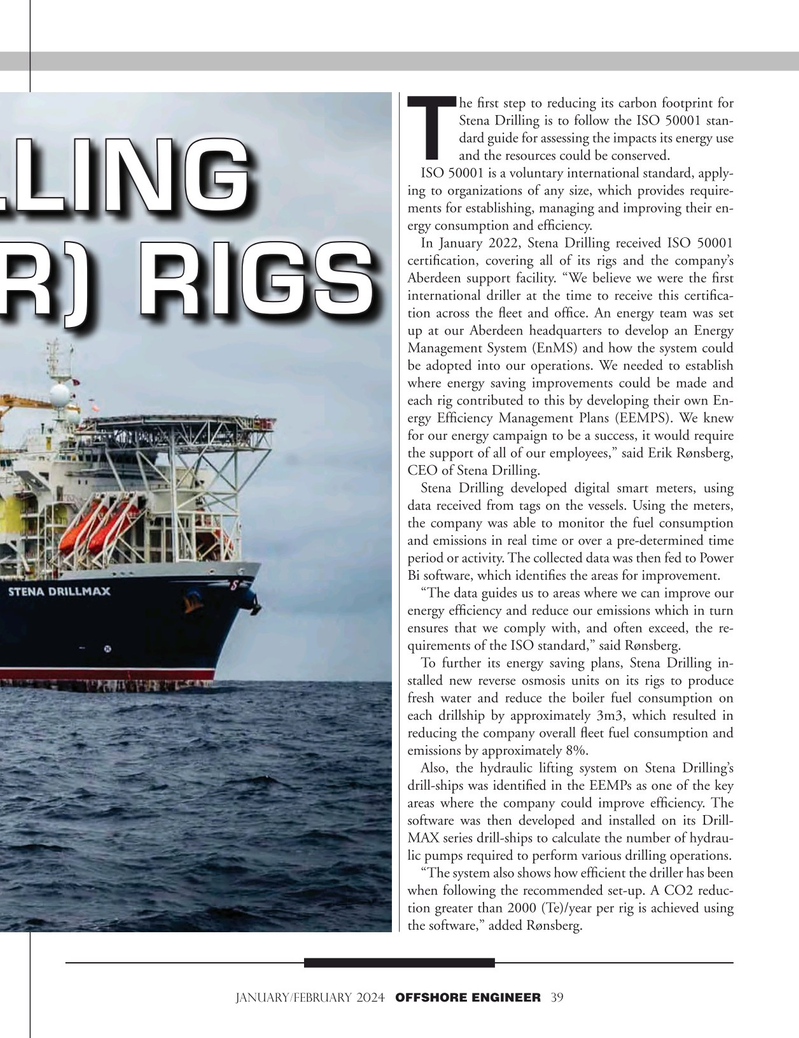
Page 39: of Offshore Engineer Magazine (Jan/Feb 2024)
Read this page in Pdf, Flash or Html5 edition of Jan/Feb 2024 Offshore Engineer Magazine
he frst step to reducing its carbon footprint for
Stena Drilling is to follow the ISO 50001 stan- dard guide for assessing the impacts its energy use
T and the resources could be conserved.
ISO 50001 is a voluntary international standard, apply- ing to organizations of any size, which provides require-
STENA DRILLING ments for establishing, managing and improving their en- ergy consumption and effciency.
In January 2022, Stena Drilling received ISO 50001 certifcation, covering all of its rigs and the company’s
Aberdeen support facility. “We believe we were the frst international driller at the time to receive this certifca-
AND GREEN(ER) RIGS tion across the feet and offce. An energy team was set up at our Aberdeen headquarters to develop an Energy
Management System (EnMS) and how the system could be adopted into our operations. We needed to establish where energy saving improvements could be made and each rig contributed to this by developing their own En- ergy Effciency Management Plans (EEMPS). We knew for our energy campaign to be a success, it would require the support of all of our employees,” said Erik Rønsberg,
CEO of Stena Drilling.
Stena Drilling developed digital smart meters, using data received from tags on the vessels. Using the meters, the company was able to monitor the fuel consumption and emissions in real time or over a pre-determined time period or activity. The collected data was then fed to Power
Bi software, which identifes the areas for improvement.
“The data guides us to areas where we can improve our energy effciency and reduce our emissions which in turn ensures that we comply with, and often exceed, the re- quirements of the ISO standard,” said Rønsberg.
To further its energy saving plans, Stena Drilling in- stalled new reverse osmosis units on its rigs to produce fresh water and reduce the boiler fuel consumption on each drillship by approximately 3m3, which resulted in reducing the company overall feet fuel consumption and emissions by approximately 8%.
Also, the hydraulic lifting system on Stena Drilling’s drill-ships was identifed in the EEMPs as one of the key areas where the company could improve effciency. The software was then developed and installed on its Drill-
MAX series drill-ships to calculate the number of hydrau- lic pumps required to perform various drilling operations.
“The system also shows how effcient the driller has been when following the recommended set-up. A CO2 reduc- tion greater than 2000 (Te)/year per rig is achieved using the software,” added Rønsberg.
january/february 2024 OFFSHORE ENGINEER 39

 38
38

 40
40